Study and Performance Analysis of Gas Engine Driven Gas Compressor
VerifiedAdded on 2023/01/03
|33
|8219
|1
Report
AI Summary
This report provides a comprehensive analysis of a reciprocating gas engine driven gas compressor, focusing on the Waukesha model L7044GSI engine driving an Ariel JGK/4 compressor used in gas lift applications. The study investigates various failure modes, including spark plug failures, engine vibration, lubrication and cooling system failures, and bearing failures, detailing their causes and potential solutions. The project aims to evaluate the engine's performance, identify root causes of failures, minimize breakdowns, and explore upgrades using modern techniques such as condition monitoring devices and PLC controllers. The report includes an introduction to reciprocating gas engines and compressors, a literature review covering relevant research, and a detailed discussion of the research methodology, results, and conclusions, offering recommendations for improved engine performance and reliability. The study also emphasizes the importance of understanding the components and systems, and the causes of the failures in the reciprocating gas engine.
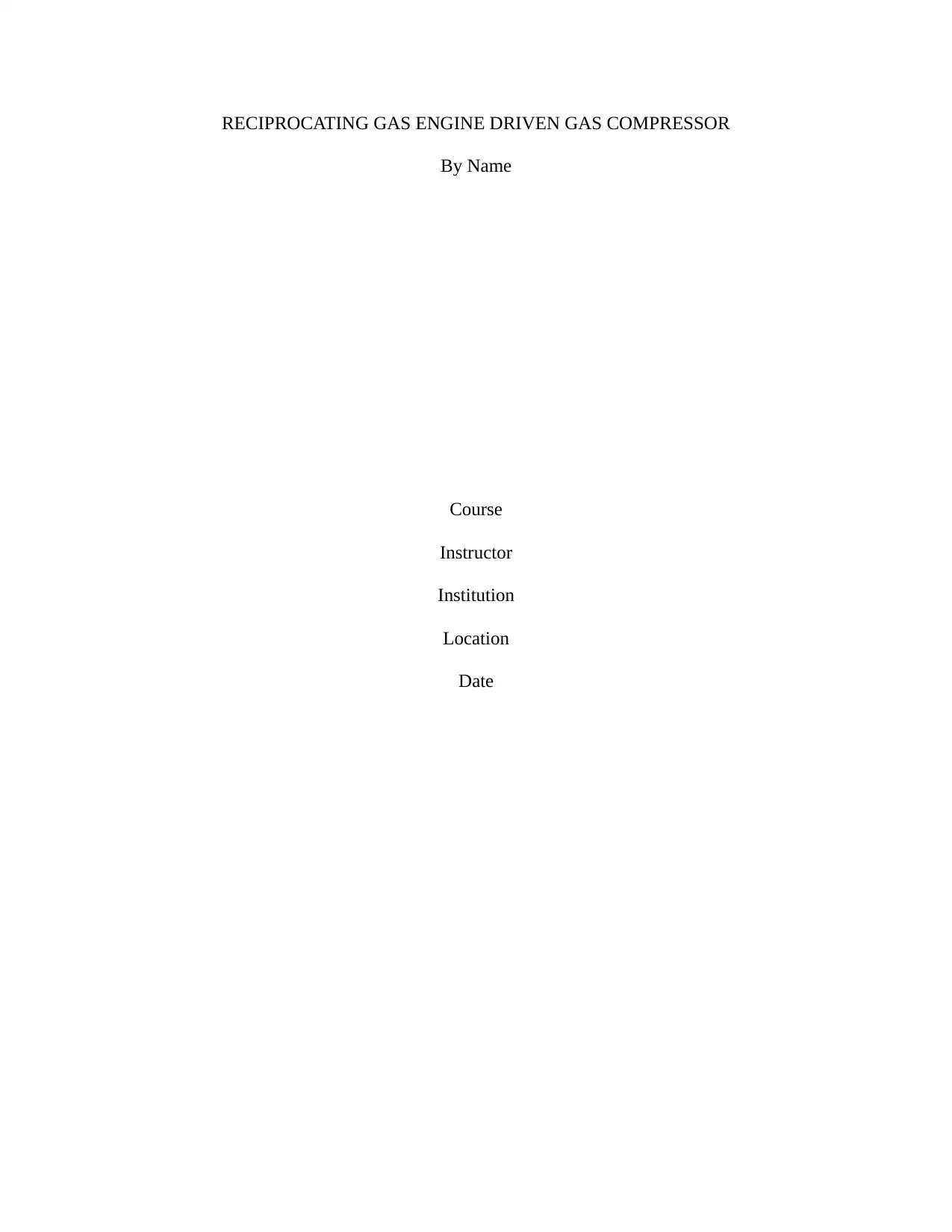
RECIPROCATING GAS ENGINE DRIVEN GAS COMPRESSOR
By Name
Course
Instructor
Institution
Location
Date
By Name
Course
Instructor
Institution
Location
Date
Paraphrase This Document
Need a fresh take? Get an instant paraphrase of this document with our AI Paraphraser
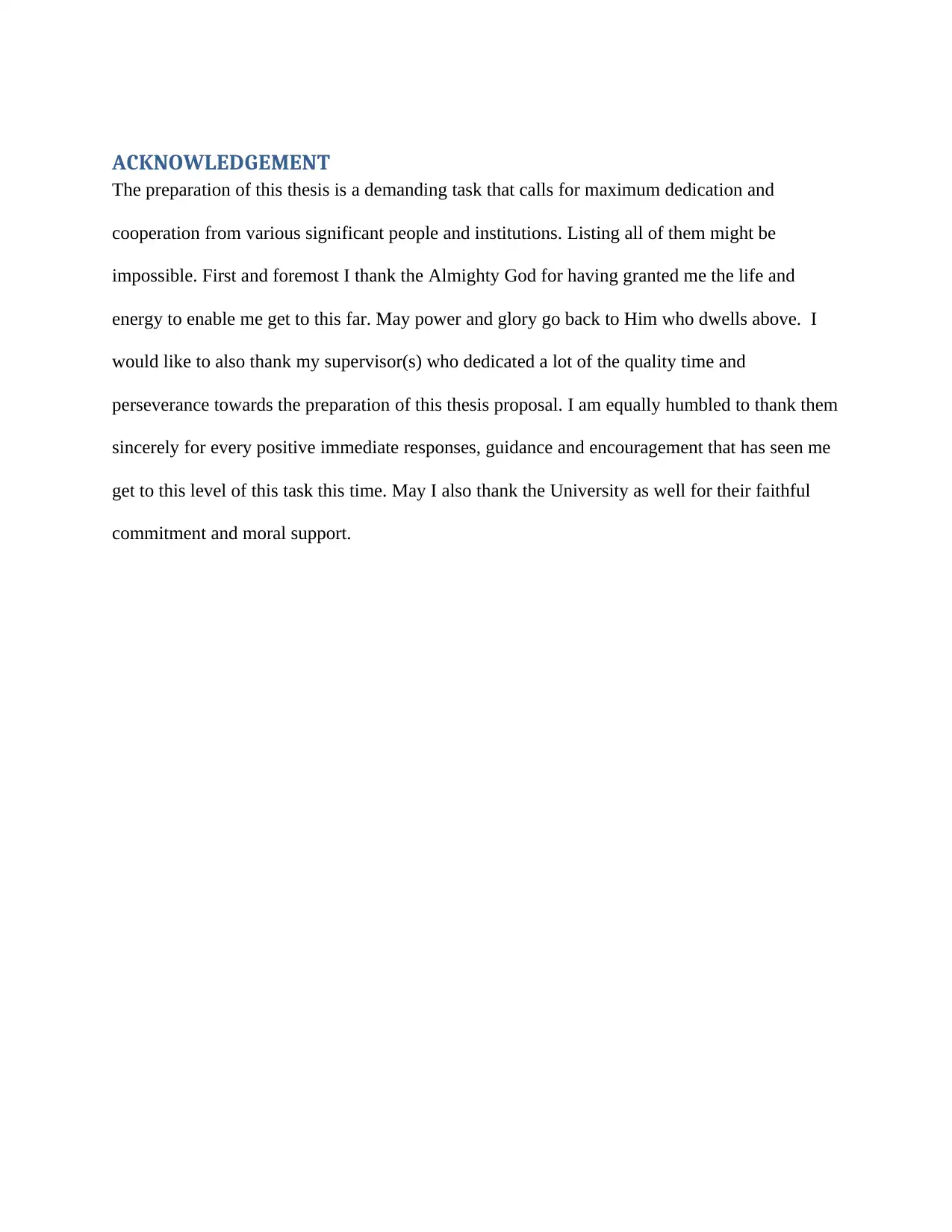
ACKNOWLEDGEMENT
The preparation of this thesis is a demanding task that calls for maximum dedication and
cooperation from various significant people and institutions. Listing all of them might be
impossible. First and foremost I thank the Almighty God for having granted me the life and
energy to enable me get to this far. May power and glory go back to Him who dwells above. I
would like to also thank my supervisor(s) who dedicated a lot of the quality time and
perseverance towards the preparation of this thesis proposal. I am equally humbled to thank them
sincerely for every positive immediate responses, guidance and encouragement that has seen me
get to this level of this task this time. May I also thank the University as well for their faithful
commitment and moral support.
The preparation of this thesis is a demanding task that calls for maximum dedication and
cooperation from various significant people and institutions. Listing all of them might be
impossible. First and foremost I thank the Almighty God for having granted me the life and
energy to enable me get to this far. May power and glory go back to Him who dwells above. I
would like to also thank my supervisor(s) who dedicated a lot of the quality time and
perseverance towards the preparation of this thesis proposal. I am equally humbled to thank them
sincerely for every positive immediate responses, guidance and encouragement that has seen me
get to this level of this task this time. May I also thank the University as well for their faithful
commitment and moral support.
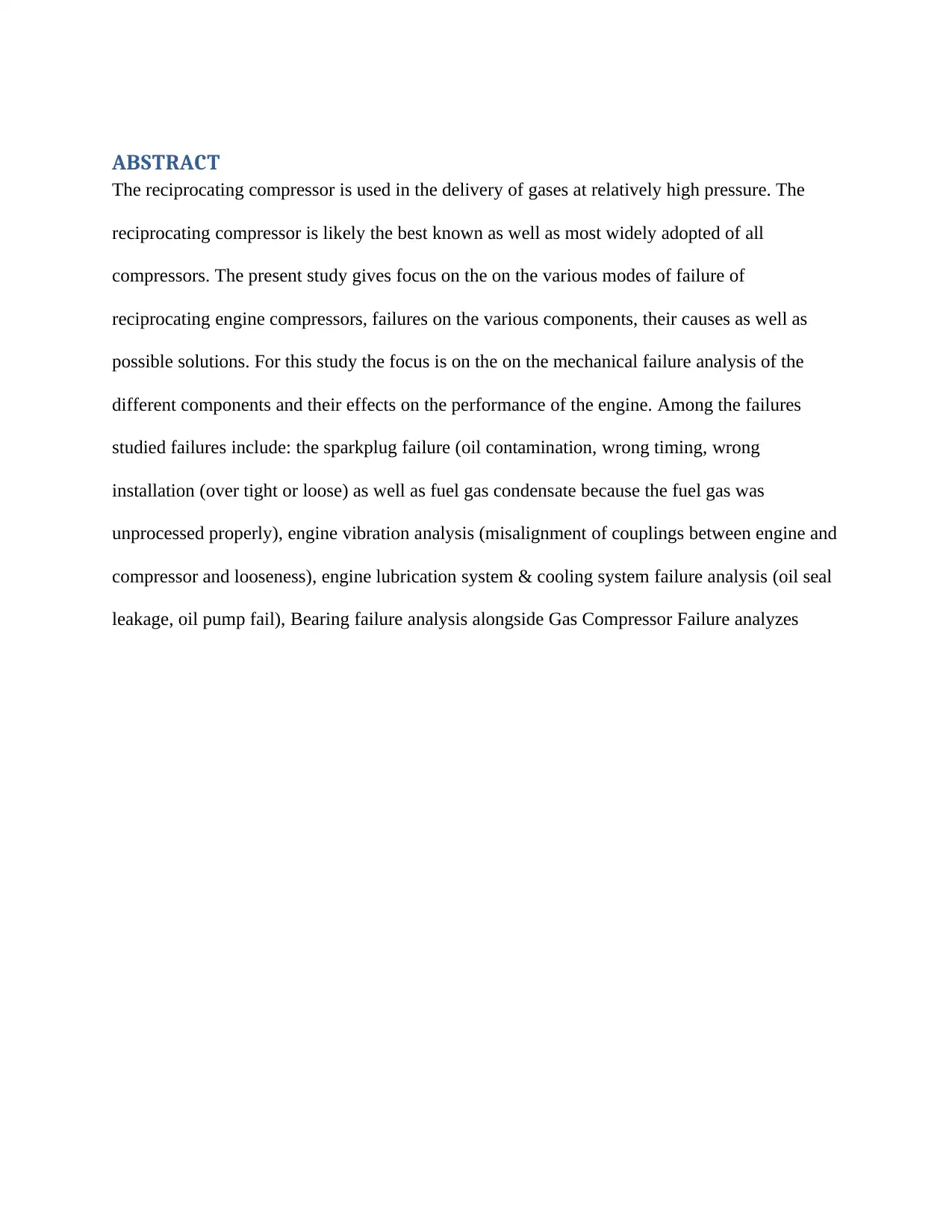
ABSTRACT
The reciprocating compressor is used in the delivery of gases at relatively high pressure. The
reciprocating compressor is likely the best known as well as most widely adopted of all
compressors. The present study gives focus on the on the various modes of failure of
reciprocating engine compressors, failures on the various components, their causes as well as
possible solutions. For this study the focus is on the on the mechanical failure analysis of the
different components and their effects on the performance of the engine. Among the failures
studied failures include: the sparkplug failure (oil contamination, wrong timing, wrong
installation (over tight or loose) as well as fuel gas condensate because the fuel gas was
unprocessed properly), engine vibration analysis (misalignment of couplings between engine and
compressor and looseness), engine lubrication system & cooling system failure analysis (oil seal
leakage, oil pump fail), Bearing failure analysis alongside Gas Compressor Failure analyzes
The reciprocating compressor is used in the delivery of gases at relatively high pressure. The
reciprocating compressor is likely the best known as well as most widely adopted of all
compressors. The present study gives focus on the on the various modes of failure of
reciprocating engine compressors, failures on the various components, their causes as well as
possible solutions. For this study the focus is on the on the mechanical failure analysis of the
different components and their effects on the performance of the engine. Among the failures
studied failures include: the sparkplug failure (oil contamination, wrong timing, wrong
installation (over tight or loose) as well as fuel gas condensate because the fuel gas was
unprocessed properly), engine vibration analysis (misalignment of couplings between engine and
compressor and looseness), engine lubrication system & cooling system failure analysis (oil seal
leakage, oil pump fail), Bearing failure analysis alongside Gas Compressor Failure analyzes
⊘ This is a preview!⊘
Do you want full access?
Subscribe today to unlock all pages.

Trusted by 1+ million students worldwide
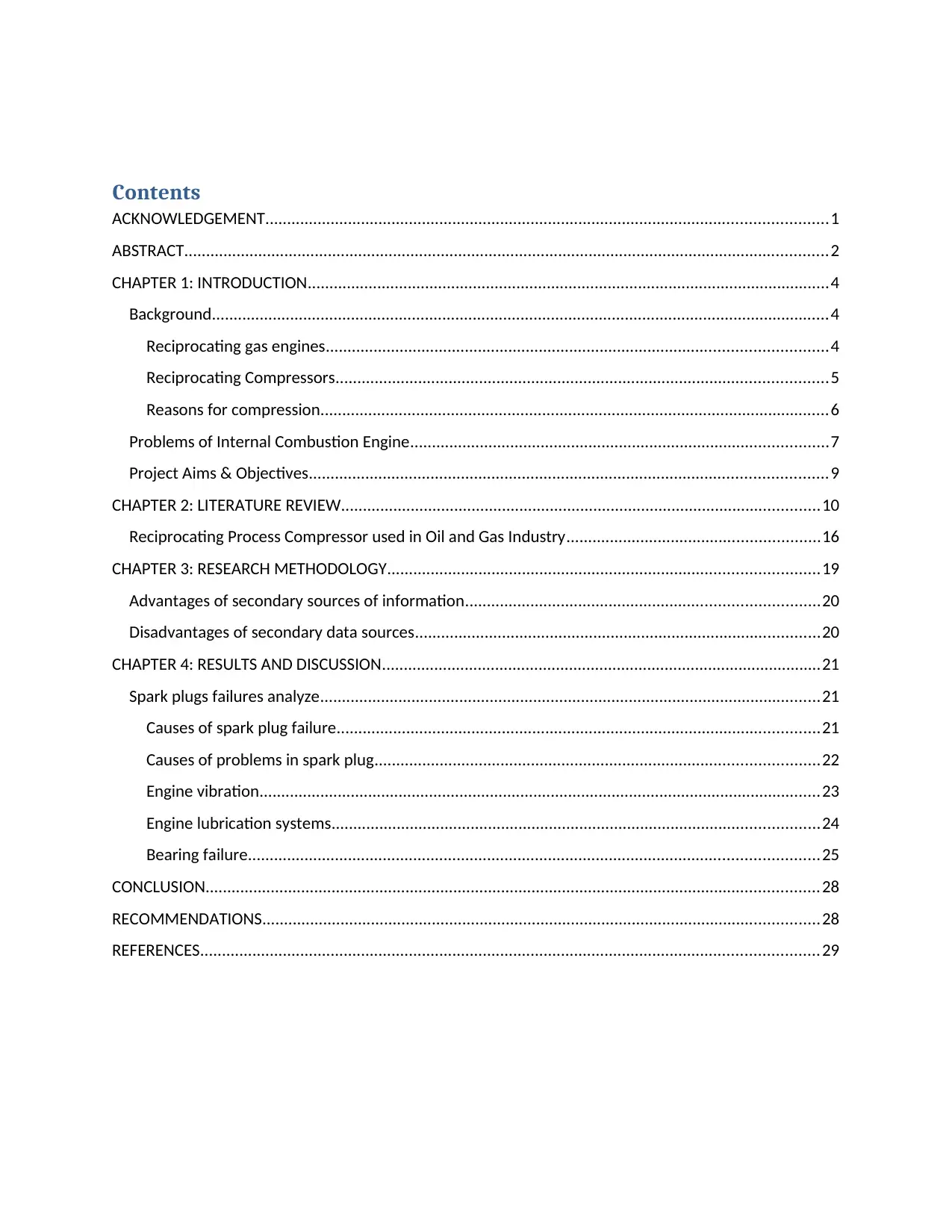
Contents
ACKNOWLEDGEMENT.................................................................................................................................1
ABSTRACT....................................................................................................................................................2
CHAPTER 1: INTRODUCTION........................................................................................................................4
Background..............................................................................................................................................4
Reciprocating gas engines...................................................................................................................4
Reciprocating Compressors.................................................................................................................5
Reasons for compression.....................................................................................................................6
Problems of Internal Combustion Engine................................................................................................7
Project Aims & Objectives.......................................................................................................................9
CHAPTER 2: LITERATURE REVIEW..............................................................................................................10
Reciprocating Process Compressor used in Oil and Gas Industry..........................................................16
CHAPTER 3: RESEARCH METHODOLOGY...................................................................................................19
Advantages of secondary sources of information.................................................................................20
Disadvantages of secondary data sources.............................................................................................20
CHAPTER 4: RESULTS AND DISCUSSION.....................................................................................................21
Spark plugs failures analyze...................................................................................................................21
Causes of spark plug failure...............................................................................................................21
Causes of problems in spark plug......................................................................................................22
Engine vibration.................................................................................................................................23
Engine lubrication systems................................................................................................................24
Bearing failure...................................................................................................................................25
CONCLUSION.............................................................................................................................................28
RECOMMENDATIONS................................................................................................................................28
REFERENCES..............................................................................................................................................29
ACKNOWLEDGEMENT.................................................................................................................................1
ABSTRACT....................................................................................................................................................2
CHAPTER 1: INTRODUCTION........................................................................................................................4
Background..............................................................................................................................................4
Reciprocating gas engines...................................................................................................................4
Reciprocating Compressors.................................................................................................................5
Reasons for compression.....................................................................................................................6
Problems of Internal Combustion Engine................................................................................................7
Project Aims & Objectives.......................................................................................................................9
CHAPTER 2: LITERATURE REVIEW..............................................................................................................10
Reciprocating Process Compressor used in Oil and Gas Industry..........................................................16
CHAPTER 3: RESEARCH METHODOLOGY...................................................................................................19
Advantages of secondary sources of information.................................................................................20
Disadvantages of secondary data sources.............................................................................................20
CHAPTER 4: RESULTS AND DISCUSSION.....................................................................................................21
Spark plugs failures analyze...................................................................................................................21
Causes of spark plug failure...............................................................................................................21
Causes of problems in spark plug......................................................................................................22
Engine vibration.................................................................................................................................23
Engine lubrication systems................................................................................................................24
Bearing failure...................................................................................................................................25
CONCLUSION.............................................................................................................................................28
RECOMMENDATIONS................................................................................................................................28
REFERENCES..............................................................................................................................................29
Paraphrase This Document
Need a fresh take? Get an instant paraphrase of this document with our AI Paraphraser
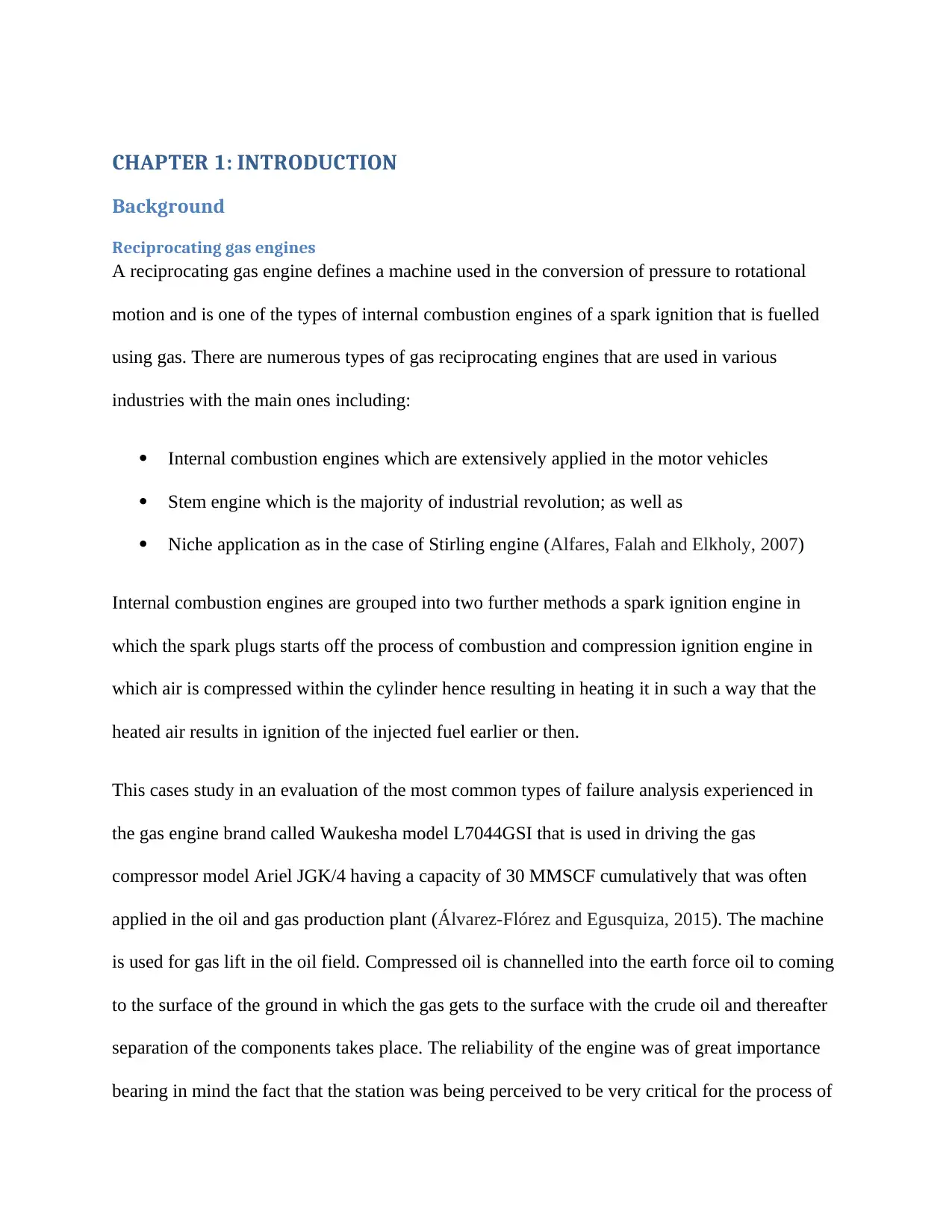
CHAPTER 1: INTRODUCTION
Background
Reciprocating gas engines
A reciprocating gas engine defines a machine used in the conversion of pressure to rotational
motion and is one of the types of internal combustion engines of a spark ignition that is fuelled
using gas. There are numerous types of gas reciprocating engines that are used in various
industries with the main ones including:
Internal combustion engines which are extensively applied in the motor vehicles
Stem engine which is the majority of industrial revolution; as well as
Niche application as in the case of Stirling engine (Alfares, Falah and Elkholy, 2007)
Internal combustion engines are grouped into two further methods a spark ignition engine in
which the spark plugs starts off the process of combustion and compression ignition engine in
which air is compressed within the cylinder hence resulting in heating it in such a way that the
heated air results in ignition of the injected fuel earlier or then.
This cases study in an evaluation of the most common types of failure analysis experienced in
the gas engine brand called Waukesha model L7044GSI that is used in driving the gas
compressor model Ariel JGK/4 having a capacity of 30 MMSCF cumulatively that was often
applied in the oil and gas production plant (Álvarez-Flórez and Egusquiza, 2015). The machine
is used for gas lift in the oil field. Compressed oil is channelled into the earth force oil to coming
to the surface of the ground in which the gas gets to the surface with the crude oil and thereafter
separation of the components takes place. The reliability of the engine was of great importance
bearing in mind the fact that the station was being perceived to be very critical for the process of
Background
Reciprocating gas engines
A reciprocating gas engine defines a machine used in the conversion of pressure to rotational
motion and is one of the types of internal combustion engines of a spark ignition that is fuelled
using gas. There are numerous types of gas reciprocating engines that are used in various
industries with the main ones including:
Internal combustion engines which are extensively applied in the motor vehicles
Stem engine which is the majority of industrial revolution; as well as
Niche application as in the case of Stirling engine (Alfares, Falah and Elkholy, 2007)
Internal combustion engines are grouped into two further methods a spark ignition engine in
which the spark plugs starts off the process of combustion and compression ignition engine in
which air is compressed within the cylinder hence resulting in heating it in such a way that the
heated air results in ignition of the injected fuel earlier or then.
This cases study in an evaluation of the most common types of failure analysis experienced in
the gas engine brand called Waukesha model L7044GSI that is used in driving the gas
compressor model Ariel JGK/4 having a capacity of 30 MMSCF cumulatively that was often
applied in the oil and gas production plant (Álvarez-Flórez and Egusquiza, 2015). The machine
is used for gas lift in the oil field. Compressed oil is channelled into the earth force oil to coming
to the surface of the ground in which the gas gets to the surface with the crude oil and thereafter
separation of the components takes place. The reliability of the engine was of great importance
bearing in mind the fact that the station was being perceived to be very critical for the process of
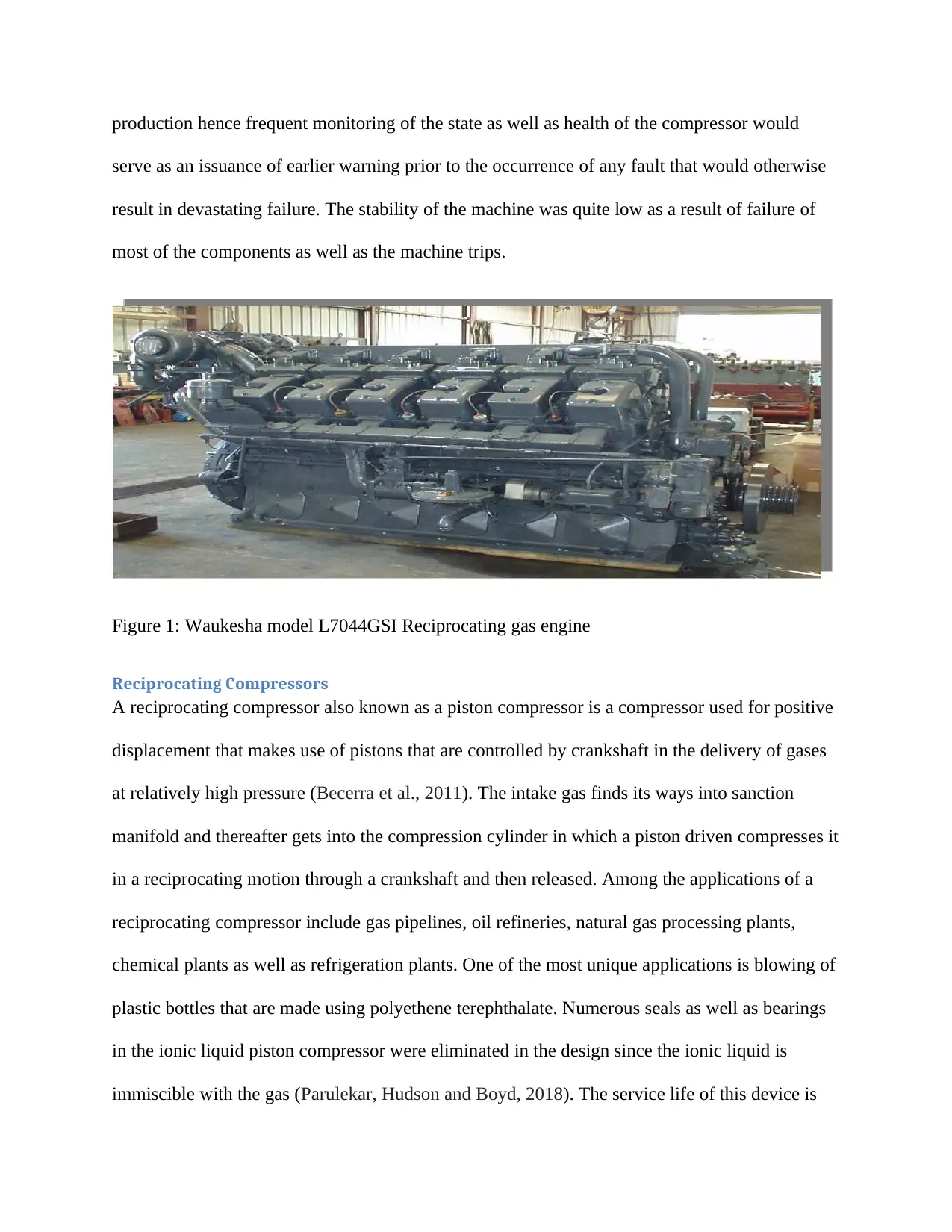
production hence frequent monitoring of the state as well as health of the compressor would
serve as an issuance of earlier warning prior to the occurrence of any fault that would otherwise
result in devastating failure. The stability of the machine was quite low as a result of failure of
most of the components as well as the machine trips.
Figure 1: Waukesha model L7044GSI Reciprocating gas engine
Reciprocating Compressors
A reciprocating compressor also known as a piston compressor is a compressor used for positive
displacement that makes use of pistons that are controlled by crankshaft in the delivery of gases
at relatively high pressure (Becerra et al., 2011). The intake gas finds its ways into sanction
manifold and thereafter gets into the compression cylinder in which a piston driven compresses it
in a reciprocating motion through a crankshaft and then released. Among the applications of a
reciprocating compressor include gas pipelines, oil refineries, natural gas processing plants,
chemical plants as well as refrigeration plants. One of the most unique applications is blowing of
plastic bottles that are made using polyethene terephthalate. Numerous seals as well as bearings
in the ionic liquid piston compressor were eliminated in the design since the ionic liquid is
immiscible with the gas (Parulekar, Hudson and Boyd, 2018). The service life of this device is
serve as an issuance of earlier warning prior to the occurrence of any fault that would otherwise
result in devastating failure. The stability of the machine was quite low as a result of failure of
most of the components as well as the machine trips.
Figure 1: Waukesha model L7044GSI Reciprocating gas engine
Reciprocating Compressors
A reciprocating compressor also known as a piston compressor is a compressor used for positive
displacement that makes use of pistons that are controlled by crankshaft in the delivery of gases
at relatively high pressure (Becerra et al., 2011). The intake gas finds its ways into sanction
manifold and thereafter gets into the compression cylinder in which a piston driven compresses it
in a reciprocating motion through a crankshaft and then released. Among the applications of a
reciprocating compressor include gas pipelines, oil refineries, natural gas processing plants,
chemical plants as well as refrigeration plants. One of the most unique applications is blowing of
plastic bottles that are made using polyethene terephthalate. Numerous seals as well as bearings
in the ionic liquid piston compressor were eliminated in the design since the ionic liquid is
immiscible with the gas (Parulekar, Hudson and Boyd, 2018). The service life of this device is
⊘ This is a preview!⊘
Do you want full access?
Subscribe today to unlock all pages.

Trusted by 1+ million students worldwide
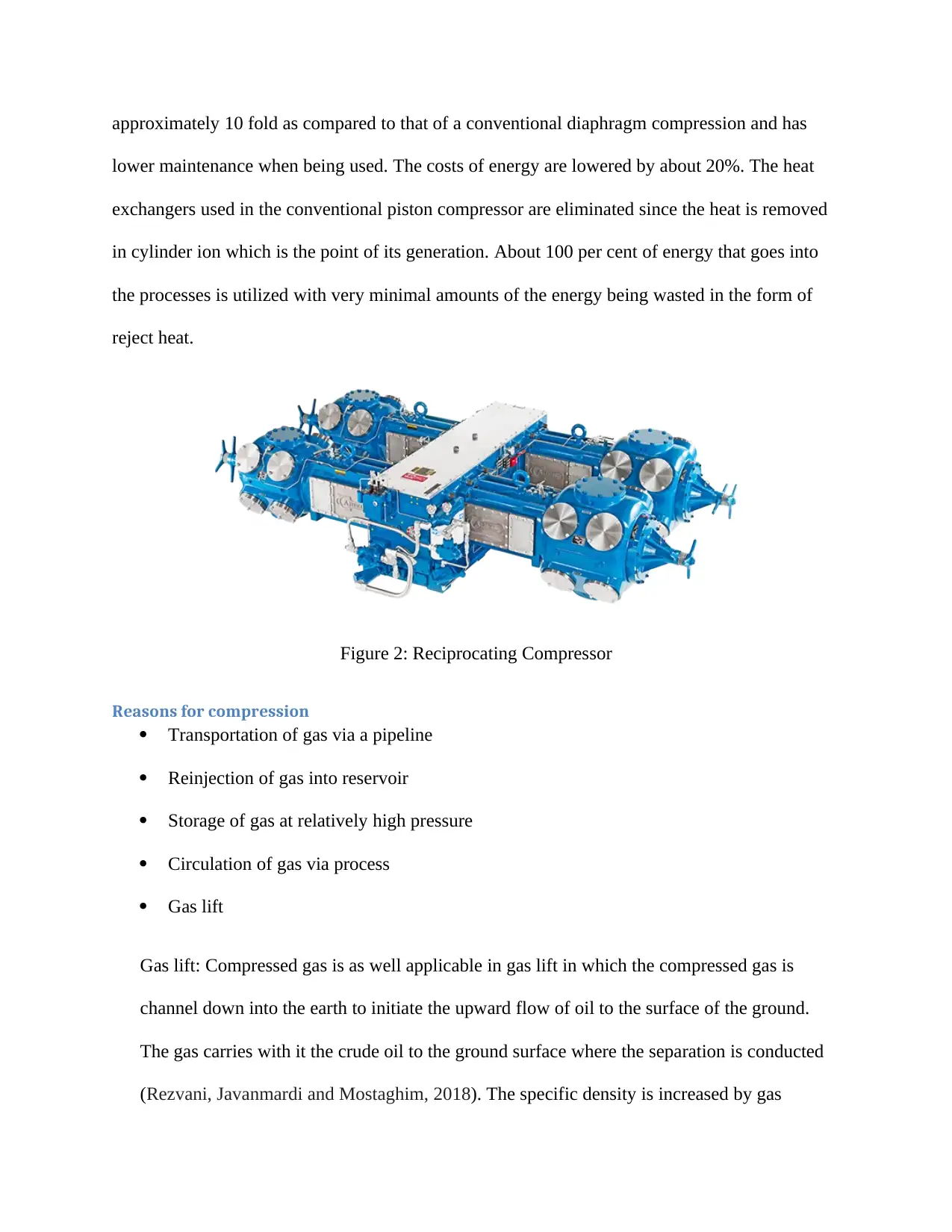
approximately 10 fold as compared to that of a conventional diaphragm compression and has
lower maintenance when being used. The costs of energy are lowered by about 20%. The heat
exchangers used in the conventional piston compressor are eliminated since the heat is removed
in cylinder ion which is the point of its generation. About 100 per cent of energy that goes into
the processes is utilized with very minimal amounts of the energy being wasted in the form of
reject heat.
Figure 2: Reciprocating Compressor
Reasons for compression
Transportation of gas via a pipeline
Reinjection of gas into reservoir
Storage of gas at relatively high pressure
Circulation of gas via process
Gas lift
Gas lift: Compressed gas is as well applicable in gas lift in which the compressed gas is
channel down into the earth to initiate the upward flow of oil to the surface of the ground.
The gas carries with it the crude oil to the ground surface where the separation is conducted
(Rezvani, Javanmardi and Mostaghim, 2018). The specific density is increased by gas
lower maintenance when being used. The costs of energy are lowered by about 20%. The heat
exchangers used in the conventional piston compressor are eliminated since the heat is removed
in cylinder ion which is the point of its generation. About 100 per cent of energy that goes into
the processes is utilized with very minimal amounts of the energy being wasted in the form of
reject heat.
Figure 2: Reciprocating Compressor
Reasons for compression
Transportation of gas via a pipeline
Reinjection of gas into reservoir
Storage of gas at relatively high pressure
Circulation of gas via process
Gas lift
Gas lift: Compressed gas is as well applicable in gas lift in which the compressed gas is
channel down into the earth to initiate the upward flow of oil to the surface of the ground.
The gas carries with it the crude oil to the ground surface where the separation is conducted
(Rezvani, Javanmardi and Mostaghim, 2018). The specific density is increased by gas
Paraphrase This Document
Need a fresh take? Get an instant paraphrase of this document with our AI Paraphraser
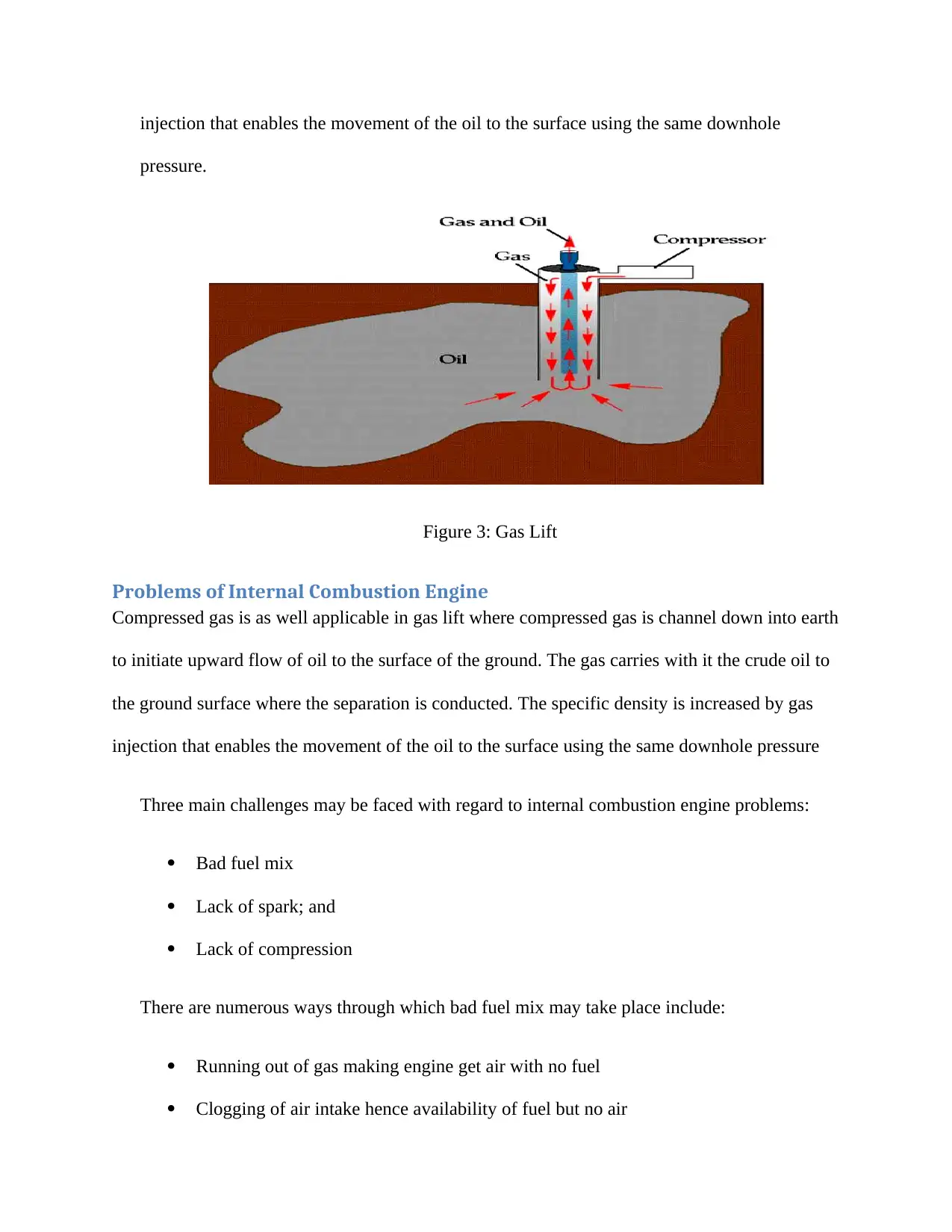
injection that enables the movement of the oil to the surface using the same downhole
pressure.
Figure 3: Gas Lift
Problems of Internal Combustion Engine
Compressed gas is as well applicable in gas lift where compressed gas is channel down into earth
to initiate upward flow of oil to the surface of the ground. The gas carries with it the crude oil to
the ground surface where the separation is conducted. The specific density is increased by gas
injection that enables the movement of the oil to the surface using the same downhole pressure
Three main challenges may be faced with regard to internal combustion engine problems:
Bad fuel mix
Lack of spark; and
Lack of compression
There are numerous ways through which bad fuel mix may take place include:
Running out of gas making engine get air with no fuel
Clogging of air intake hence availability of fuel but no air
pressure.
Figure 3: Gas Lift
Problems of Internal Combustion Engine
Compressed gas is as well applicable in gas lift where compressed gas is channel down into earth
to initiate upward flow of oil to the surface of the ground. The gas carries with it the crude oil to
the ground surface where the separation is conducted. The specific density is increased by gas
injection that enables the movement of the oil to the surface using the same downhole pressure
Three main challenges may be faced with regard to internal combustion engine problems:
Bad fuel mix
Lack of spark; and
Lack of compression
There are numerous ways through which bad fuel mix may take place include:
Running out of gas making engine get air with no fuel
Clogging of air intake hence availability of fuel but no air
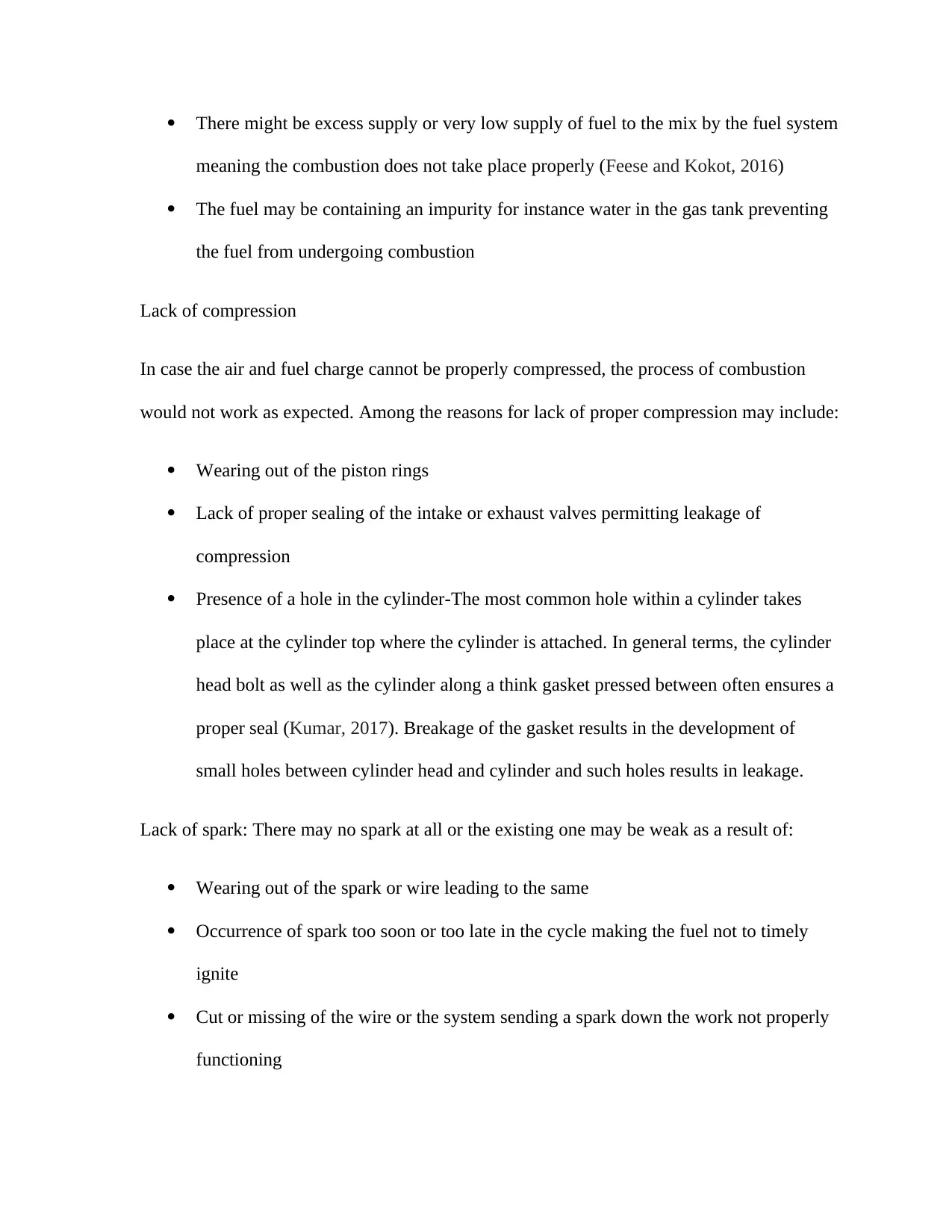
There might be excess supply or very low supply of fuel to the mix by the fuel system
meaning the combustion does not take place properly (Feese and Kokot, 2016)
The fuel may be containing an impurity for instance water in the gas tank preventing
the fuel from undergoing combustion
Lack of compression
In case the air and fuel charge cannot be properly compressed, the process of combustion
would not work as expected. Among the reasons for lack of proper compression may include:
Wearing out of the piston rings
Lack of proper sealing of the intake or exhaust valves permitting leakage of
compression
Presence of a hole in the cylinder-The most common hole within a cylinder takes
place at the cylinder top where the cylinder is attached. In general terms, the cylinder
head bolt as well as the cylinder along a think gasket pressed between often ensures a
proper seal (Kumar, 2017). Breakage of the gasket results in the development of
small holes between cylinder head and cylinder and such holes results in leakage.
Lack of spark: There may no spark at all or the existing one may be weak as a result of:
Wearing out of the spark or wire leading to the same
Occurrence of spark too soon or too late in the cycle making the fuel not to timely
ignite
Cut or missing of the wire or the system sending a spark down the work not properly
functioning
meaning the combustion does not take place properly (Feese and Kokot, 2016)
The fuel may be containing an impurity for instance water in the gas tank preventing
the fuel from undergoing combustion
Lack of compression
In case the air and fuel charge cannot be properly compressed, the process of combustion
would not work as expected. Among the reasons for lack of proper compression may include:
Wearing out of the piston rings
Lack of proper sealing of the intake or exhaust valves permitting leakage of
compression
Presence of a hole in the cylinder-The most common hole within a cylinder takes
place at the cylinder top where the cylinder is attached. In general terms, the cylinder
head bolt as well as the cylinder along a think gasket pressed between often ensures a
proper seal (Kumar, 2017). Breakage of the gasket results in the development of
small holes between cylinder head and cylinder and such holes results in leakage.
Lack of spark: There may no spark at all or the existing one may be weak as a result of:
Wearing out of the spark or wire leading to the same
Occurrence of spark too soon or too late in the cycle making the fuel not to timely
ignite
Cut or missing of the wire or the system sending a spark down the work not properly
functioning
⊘ This is a preview!⊘
Do you want full access?
Subscribe today to unlock all pages.

Trusted by 1+ million students worldwide
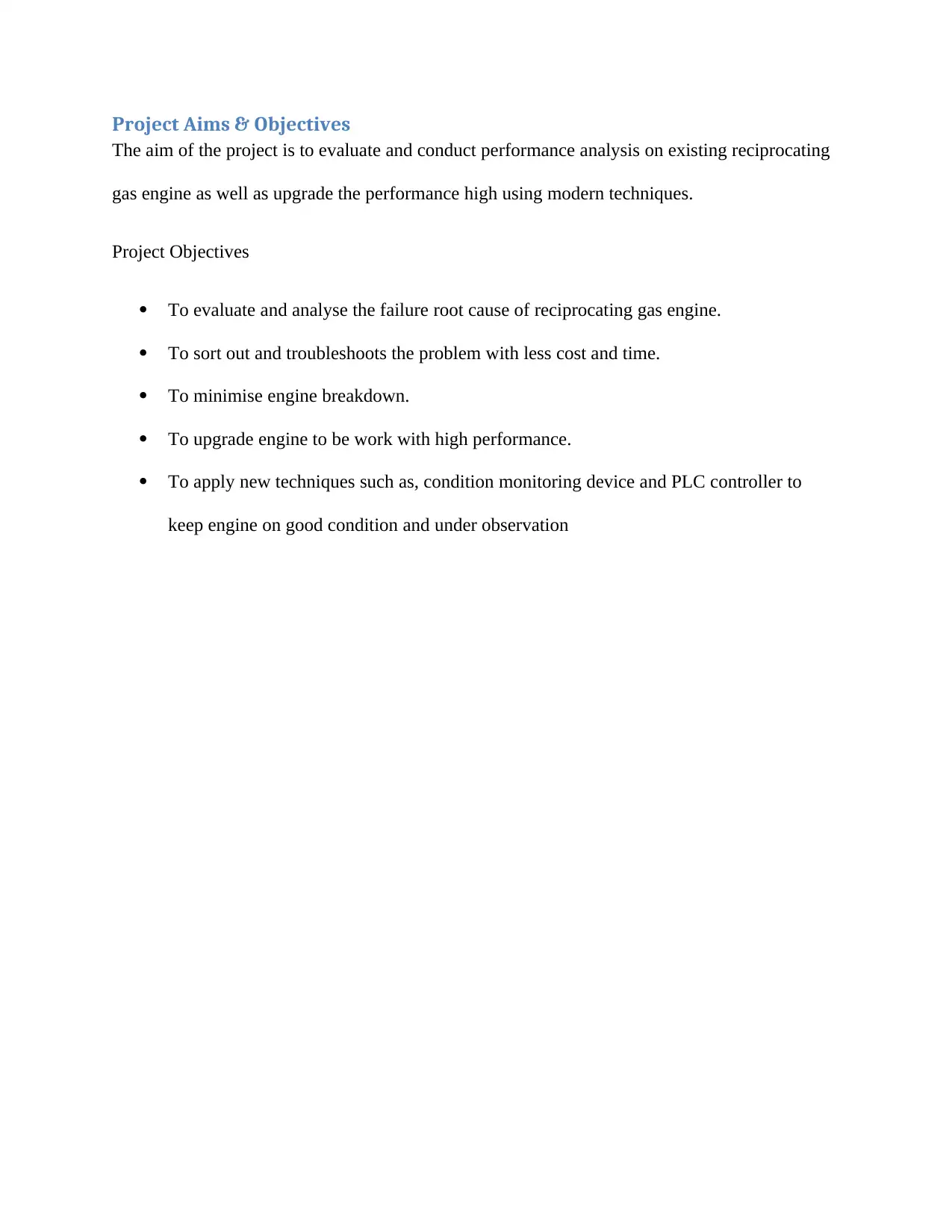
Project Aims & Objectives
The aim of the project is to evaluate and conduct performance analysis on existing reciprocating
gas engine as well as upgrade the performance high using modern techniques.
Project Objectives
To evaluate and analyse the failure root cause of reciprocating gas engine.
To sort out and troubleshoots the problem with less cost and time.
To minimise engine breakdown.
To upgrade engine to be work with high performance.
To apply new techniques such as, condition monitoring device and PLC controller to
keep engine on good condition and under observation
The aim of the project is to evaluate and conduct performance analysis on existing reciprocating
gas engine as well as upgrade the performance high using modern techniques.
Project Objectives
To evaluate and analyse the failure root cause of reciprocating gas engine.
To sort out and troubleshoots the problem with less cost and time.
To minimise engine breakdown.
To upgrade engine to be work with high performance.
To apply new techniques such as, condition monitoring device and PLC controller to
keep engine on good condition and under observation
Paraphrase This Document
Need a fresh take? Get an instant paraphrase of this document with our AI Paraphraser
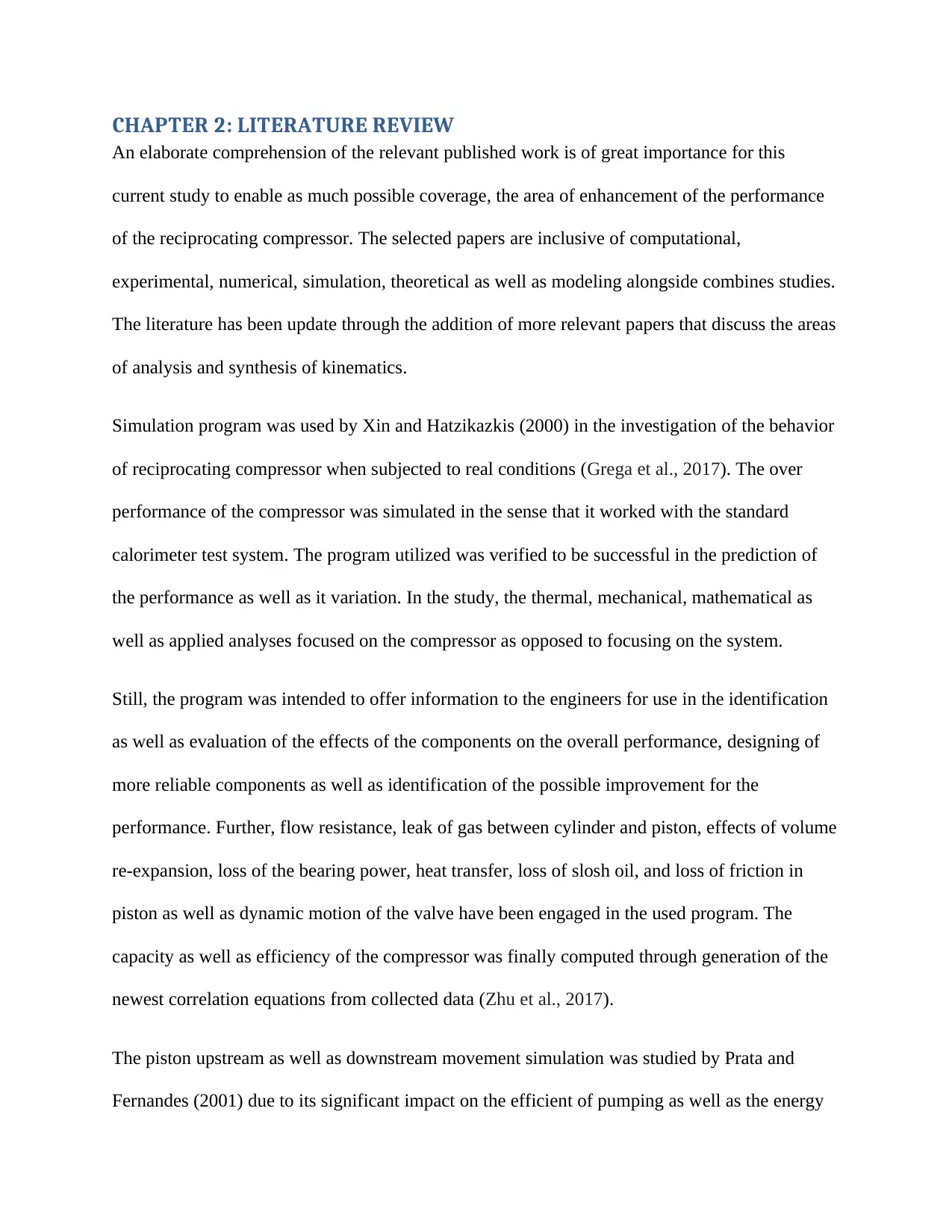
CHAPTER 2: LITERATURE REVIEW
An elaborate comprehension of the relevant published work is of great importance for this
current study to enable as much possible coverage, the area of enhancement of the performance
of the reciprocating compressor. The selected papers are inclusive of computational,
experimental, numerical, simulation, theoretical as well as modeling alongside combines studies.
The literature has been update through the addition of more relevant papers that discuss the areas
of analysis and synthesis of kinematics.
Simulation program was used by Xin and Hatzikazkis (2000) in the investigation of the behavior
of reciprocating compressor when subjected to real conditions (Grega et al., 2017). The over
performance of the compressor was simulated in the sense that it worked with the standard
calorimeter test system. The program utilized was verified to be successful in the prediction of
the performance as well as it variation. In the study, the thermal, mechanical, mathematical as
well as applied analyses focused on the compressor as opposed to focusing on the system.
Still, the program was intended to offer information to the engineers for use in the identification
as well as evaluation of the effects of the components on the overall performance, designing of
more reliable components as well as identification of the possible improvement for the
performance. Further, flow resistance, leak of gas between cylinder and piston, effects of volume
re-expansion, loss of the bearing power, heat transfer, loss of slosh oil, and loss of friction in
piston as well as dynamic motion of the valve have been engaged in the used program. The
capacity as well as efficiency of the compressor was finally computed through generation of the
newest correlation equations from collected data (Zhu et al., 2017).
The piston upstream as well as downstream movement simulation was studied by Prata and
Fernandes (2001) due to its significant impact on the efficient of pumping as well as the energy
An elaborate comprehension of the relevant published work is of great importance for this
current study to enable as much possible coverage, the area of enhancement of the performance
of the reciprocating compressor. The selected papers are inclusive of computational,
experimental, numerical, simulation, theoretical as well as modeling alongside combines studies.
The literature has been update through the addition of more relevant papers that discuss the areas
of analysis and synthesis of kinematics.
Simulation program was used by Xin and Hatzikazkis (2000) in the investigation of the behavior
of reciprocating compressor when subjected to real conditions (Grega et al., 2017). The over
performance of the compressor was simulated in the sense that it worked with the standard
calorimeter test system. The program utilized was verified to be successful in the prediction of
the performance as well as it variation. In the study, the thermal, mechanical, mathematical as
well as applied analyses focused on the compressor as opposed to focusing on the system.
Still, the program was intended to offer information to the engineers for use in the identification
as well as evaluation of the effects of the components on the overall performance, designing of
more reliable components as well as identification of the possible improvement for the
performance. Further, flow resistance, leak of gas between cylinder and piston, effects of volume
re-expansion, loss of the bearing power, heat transfer, loss of slosh oil, and loss of friction in
piston as well as dynamic motion of the valve have been engaged in the used program. The
capacity as well as efficiency of the compressor was finally computed through generation of the
newest correlation equations from collected data (Zhu et al., 2017).
The piston upstream as well as downstream movement simulation was studied by Prata and
Fernandes (2001) due to its significant impact on the efficient of pumping as well as the energy
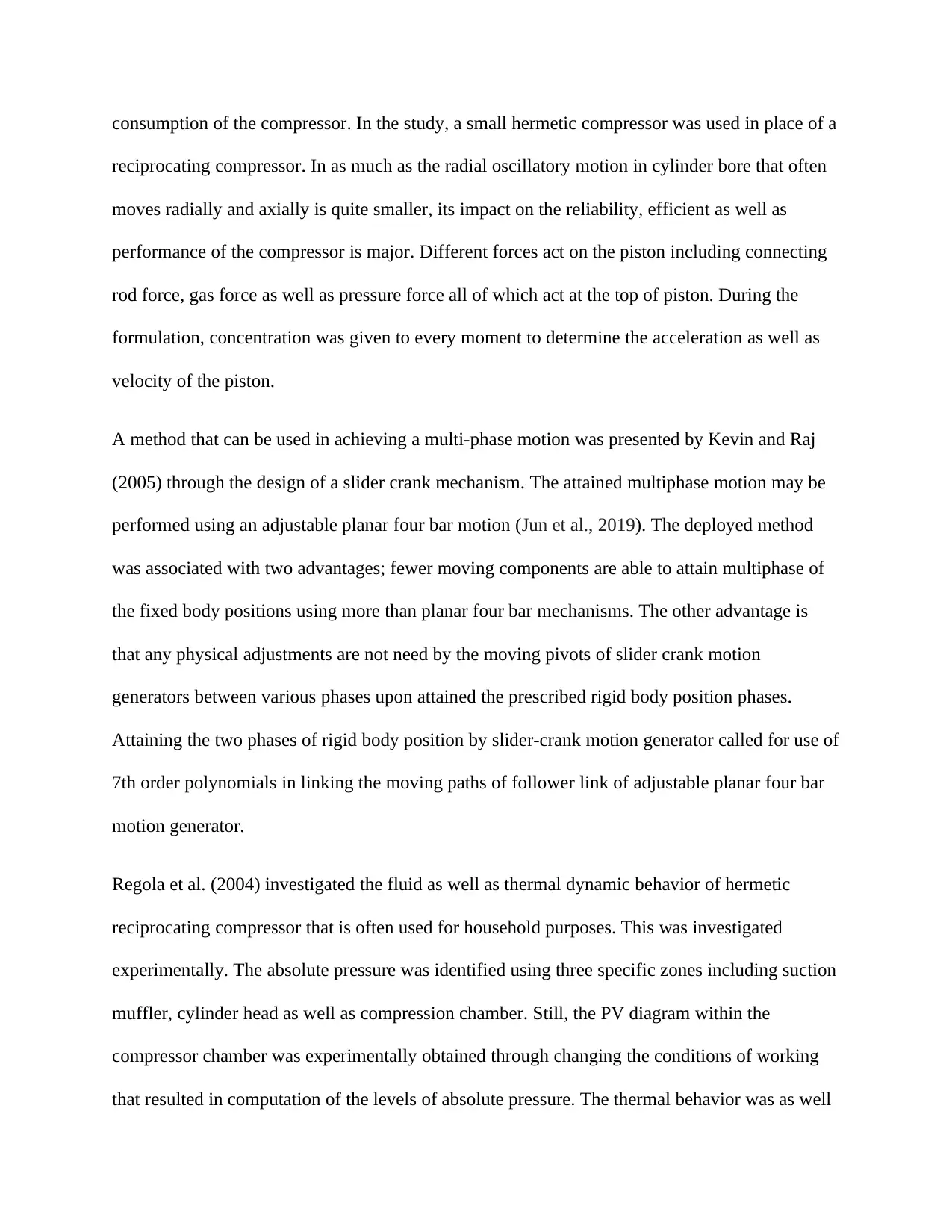
consumption of the compressor. In the study, a small hermetic compressor was used in place of a
reciprocating compressor. In as much as the radial oscillatory motion in cylinder bore that often
moves radially and axially is quite smaller, its impact on the reliability, efficient as well as
performance of the compressor is major. Different forces act on the piston including connecting
rod force, gas force as well as pressure force all of which act at the top of piston. During the
formulation, concentration was given to every moment to determine the acceleration as well as
velocity of the piston.
A method that can be used in achieving a multi-phase motion was presented by Kevin and Raj
(2005) through the design of a slider crank mechanism. The attained multiphase motion may be
performed using an adjustable planar four bar motion (Jun et al., 2019). The deployed method
was associated with two advantages; fewer moving components are able to attain multiphase of
the fixed body positions using more than planar four bar mechanisms. The other advantage is
that any physical adjustments are not need by the moving pivots of slider crank motion
generators between various phases upon attained the prescribed rigid body position phases.
Attaining the two phases of rigid body position by slider-crank motion generator called for use of
7th order polynomials in linking the moving paths of follower link of adjustable planar four bar
motion generator.
Regola et al. (2004) investigated the fluid as well as thermal dynamic behavior of hermetic
reciprocating compressor that is often used for household purposes. This was investigated
experimentally. The absolute pressure was identified using three specific zones including suction
muffler, cylinder head as well as compression chamber. Still, the PV diagram within the
compressor chamber was experimentally obtained through changing the conditions of working
that resulted in computation of the levels of absolute pressure. The thermal behavior was as well
reciprocating compressor. In as much as the radial oscillatory motion in cylinder bore that often
moves radially and axially is quite smaller, its impact on the reliability, efficient as well as
performance of the compressor is major. Different forces act on the piston including connecting
rod force, gas force as well as pressure force all of which act at the top of piston. During the
formulation, concentration was given to every moment to determine the acceleration as well as
velocity of the piston.
A method that can be used in achieving a multi-phase motion was presented by Kevin and Raj
(2005) through the design of a slider crank mechanism. The attained multiphase motion may be
performed using an adjustable planar four bar motion (Jun et al., 2019). The deployed method
was associated with two advantages; fewer moving components are able to attain multiphase of
the fixed body positions using more than planar four bar mechanisms. The other advantage is
that any physical adjustments are not need by the moving pivots of slider crank motion
generators between various phases upon attained the prescribed rigid body position phases.
Attaining the two phases of rigid body position by slider-crank motion generator called for use of
7th order polynomials in linking the moving paths of follower link of adjustable planar four bar
motion generator.
Regola et al. (2004) investigated the fluid as well as thermal dynamic behavior of hermetic
reciprocating compressor that is often used for household purposes. This was investigated
experimentally. The absolute pressure was identified using three specific zones including suction
muffler, cylinder head as well as compression chamber. Still, the PV diagram within the
compressor chamber was experimentally obtained through changing the conditions of working
that resulted in computation of the levels of absolute pressure. The thermal behavior was as well
⊘ This is a preview!⊘
Do you want full access?
Subscribe today to unlock all pages.

Trusted by 1+ million students worldwide
1 out of 33
Your All-in-One AI-Powered Toolkit for Academic Success.
+13062052269
info@desklib.com
Available 24*7 on WhatsApp / Email
![[object Object]](/_next/static/media/star-bottom.7253800d.svg)
Unlock your academic potential
Copyright © 2020–2025 A2Z Services. All Rights Reserved. Developed and managed by ZUCOL.